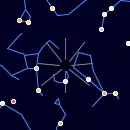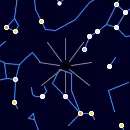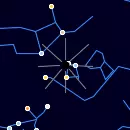Active Meteor Showers
Meteor showers offer some of the most captivating celestial displays of the year. In this section, you'll find information about the active meteor showers visible in the sky right now or coming soon. From the radiant points to peak dates, we provide everything you need to catch these stunning events. Whether you're an experienced stargazer or a newcomer, these active meteor showers are your guide to the best skywatching opportunities.
Sky Map
Celectial bearing and elevation at 16:07
This interactive starmap highlights the active meteor showers currently visible in the sky. By showing the radiant points and the positions of the showers, it helps you easily identify the best viewing locations for each event. Track meteor shower activity throughout the year and plan your observations with this dynamic, real-time guide to the night sky. Whether you're a seasoned observer or a first-time stargazer, this starmap is your tool to follow the paths of the most spectacular meteor showers as they light up the heavens.
Meteor Showers
sigma-Hydrids
Meteor Shower
sigma-Hydrids meteor shower is an annual event that peaks on December 09, with activity occurring from November 19 to January 11.
December sigma-Virginids
Meteor Shower
December sigma-Virginids meteor shower is an annual event that peaks on December 23, with activity occurring from November 23 to January 20.
Comae Berenicids
Meteor Shower
Comae Berenicids meteor shower is an annual event that peaks on December 24, with activity occurring from November 27 to February 15.
alpha-Hydrids
Meteor Shower
alpha-Hydrids meteor shower is an annual event that peaks on January 02, with activity occurring from December 18 to January 17.
Quadrantids
Meteor Shower
Quadrantids meteor shower is an annual event that peaks on January 03, with activity occurring from December 31 to January 10.
Southern delta-Cancrids
Meteor Shower
Southern delta-Cancrids meteor shower is an annual event that peaks on January 07, with activity occurring from December 21 to January 29.
theta-Coronae Borealids
Meteor Shower
theta-Coronae Borealids meteor shower is an annual event that peaks on January 16, with activity occurring from January 07 to January 24.
lambda-Bootids
Meteor Shower
lambda-Bootids meteor shower is an annual event that peaks on January 16, with activity occurring from December 31 to January 17.
Northern delta-Cancrids
Meteor Shower
Northern delta-Cancrids meteor shower is an annual event that peaks on January 17, with activity occurring from December 27 to February 09.
eta-Corvids
Meteor Shower
eta-Corvids meteor shower is an annual event that peaks on January 19, with activity occurring from December 31 to February 08.
Data Credits
We would like to express our gratitude to the International Astronomical Union (IAU) Meteor Center for providing valuable meteor data.
Special thanks to all the astronomers, researchers, and enthusiasts whose work contributes to the understanding and observation of meteor showers.










